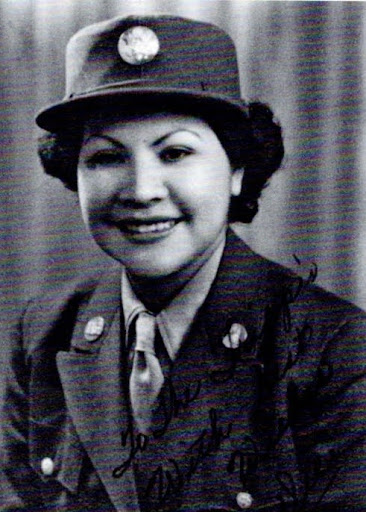Overview
Original Patriots: First Hand Accounts of California Indian Veterans of World War II (Part 2)

Author: Trelasa Baratta (Pomo, primary author) & Taylor Pennewell (Maidu, Editor/Co-author) - Redbud Resource Group.
Lesson partner: Rebecca Lowry and Maggie Peters, Humboldt County Office of Education
Grades: 9-12
Suggested Amount of Time: 90 minutes (1-2 class sessions)
Curriculum Themes
- History
- Cultural Strengths
- Law/Government
- Relationship to Place
Learning Goals
Analyze first-person narratives to identify themes of motivation, sacrifice, and resilience among Native American WWII veterans.
Explain how Native veterans maintained their cultural identity and connection to homeland while serving abroad.
Reflect on and discuss the broader significance of Native American contributions to U.S. history, particularly in military service.
Unit Overview
This lesson explores the overlooked contributions of Native American veterans during World War II through first-person narratives. Students engage in activities that build historical understanding, such as discussing quotes, analyzing facts, and participating in a jigsaw reading activity. The lesson emphasizes the duality of Native American identity and service while addressing themes of resilience, motivation, and historical erasure. In order to build upon historical background knowledge, educators should first complete the lesson “US Assimilationist Policy and California’s Indigenous Peoples” with their class prior to this lesson.
Essential questions:
How did Native American veterans balance their cultural identity with their service to the United States during World War II?
Why did Native Americans choose to serve in the U.S. military despite the injustices they faced?
How can learning about these veterans’ stories challenge historical erasure and deepen our understanding of Native American contributions to history?
The teacher must understand that despite our tragic history, Native communities continue to find hope, look to the future, and lead the way in repairing our relationships to local ecosystems.
The teacher must be prepared to actively engage in conversations about resistance and resilience throughout this lesson.
Teacher Background
This lesson centers on The Original Patriots: Northern California Indian Veterans of World War II by Chag Lowry, a historian and author of Yurok, Maidu, and Achumawi ancestry. Lowry’s work preserves the lives and experiences of Native American veterans who served in WWII, highlighting their motivations, sacrifices, and contributions to both their homelands and the United States.
The lesson introduces students to themes of resilience, identity, and belonging through the personal stories of four veterans. To fully engage with this material, teachers should familiarize themselves with the historical context of U.S. assimilationist policies and Native boarding schools (see Lesson 1: U.S. Assimilationist Policies and California Native Americans). These policies shaped the lives of many Native veterans, influencing both their military service and their post-war experiences. The veterans’ stories reflect the dual identity they navigated: a deep allegiance to their homelands and a commitment to serving a country that had marginalized them.
Historical and Cultural Context
California’s Native peoples endured state-sanctioned violence, land theft, and genocide during the 19th century, leaving lasting scars on Tribal communities. Many veterans’ families directly survived these atrocities, which shaped their perspectives on service and sacrifice. While the experiences and motivations of Native veterans varied, a shared connection to their homelands played a central role during their time in the military and afterward.
These stories are often missing from mainstream historical narratives. This lesson aims to address this erasure by centering the voices and experiences of Native veterans, providing students with a more inclusive understanding of American history.
Trigger Warning
As a California Native curriculum writer, I found the process of creating this lesson both meaningful and emotionally challenging. My grandfather, a Pomo/Lake Miwok man, served in WWII. Although he passed before I was born, I learned from my family that he never shared his war experiences. My relatives told me that my grandfather faced relentless racism growing up Indian in Lake County, California, and that his motivation to serve stemmed from a desire to prove—to himself and to non-Natives—that he was just as worthy of U.S. citizenship as anyone else. Born in 1918, my grandfather was not granted citizenship at birth, as Native Americans were not recognized as U.S. citizens until 1924.
Reading interviews with other California Native veterans forced me to imagine not only what my grandfather endured during the war but also what he faced before and after his service. He passed in 1974 from complications related to diabetes, leaving behind unanswered questions about his experiences.
Supporting Students Emotionally
This lesson addresses complex and emotionally heavy topics, including boarding school trauma, war experiences, and systemic racism. You may have students—Native and non-Native—whose ancestors or relatives served in wars or are currently serving. Some students may have access to these stories, while others may not.
To support students:
Acknowledge emotional triggers: Following the Turn and Talk activity, take a moment to recognize the potential for emotional responses.
Provide safe spaces: Offer students the option to step away or speak with a trusted adult or counselor if they feel overwhelmed.
Guide discussions with care: Create a respectful and thoughtful classroom environment, emphasizing that the goal is to honor the resilience and contributions of Native veterans.
Check in individually: If a student appears upset, provide an opportunity for one-on-one support.

